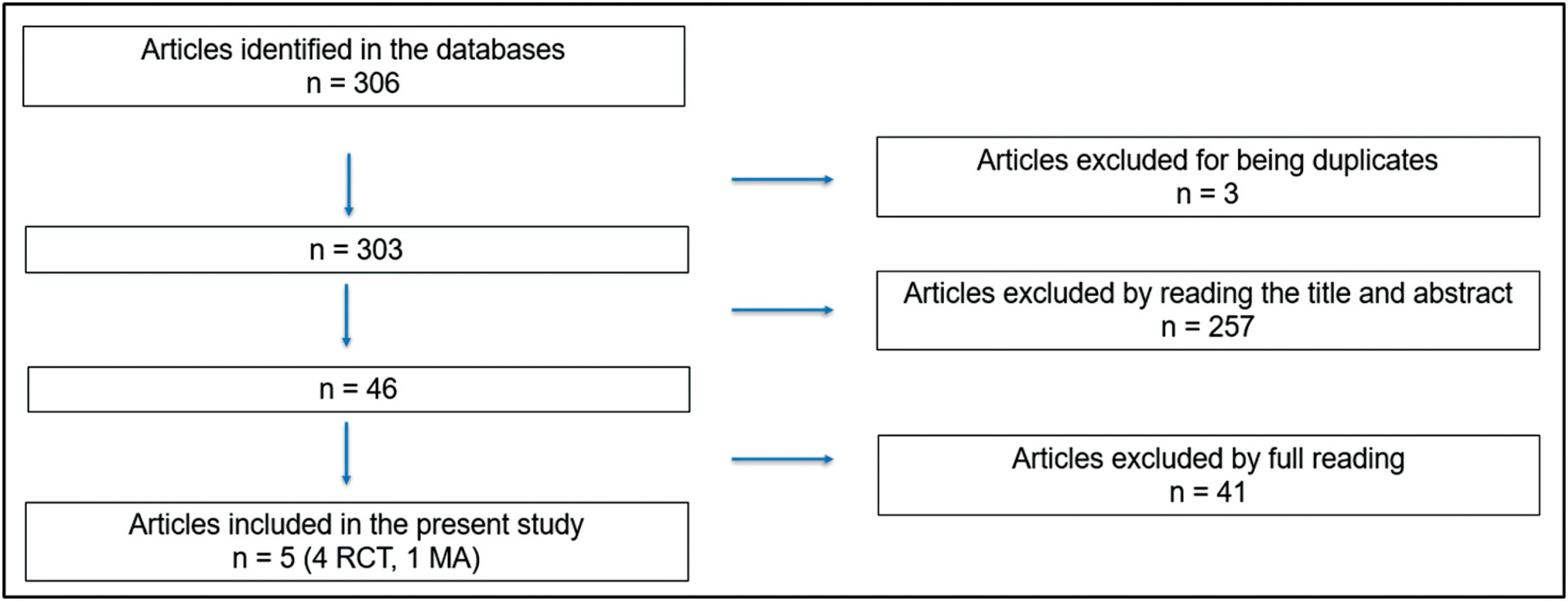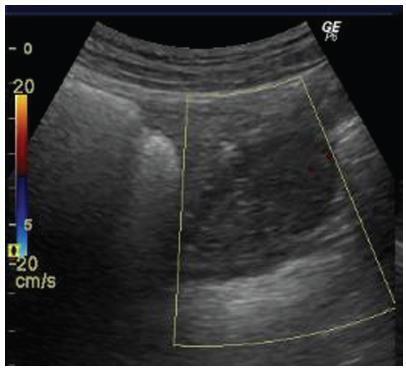Summary
Revista Brasileira de Ginecologia e Obstetrícia. 2023;45(11):724-728
To determine if the use of lubricating gel on the speculum during the cervicovaginal cytology examination interferes with the results obtained, as well as whether it reduces reported discomfort in patients.
A systematic review was carried out according to the Preferred Reporting Items for Systematic Reviews and Meta-Analyses (PRISMA) recommendations, with a search in the Pubmed/Medline, Scielo, Cochrane Library, Embase databases of articles published between January 2011 and May 2022. The keywords used were cytology, speculum, lubricant, result, and pain.
The initial search resulted in 306 articles, of which were excluded three because they were duplicates, 257 after reading the title and abstract and 41 after reading the full text. Thus, five articles were selected for the study: four randomized clinical trials and one metanalysis.
The selection of articles was performed by two investigators. The 5 selected articles were read in full and submitted to a comparative analysis.
Screening through cervicovaginal cytology allows for early diagnosis and reduction of associated mortality, but the procedure can be associated with pain. A small amount of aqueous lubricating gel in the speculum can be used to reduce the discomfort associated with performing cervicovaginal cytology.
The use of lubricating gel in the speculum does not seem to be associated with a change in the cytology result and reduces the discomfort associated with its insertion into the vagina.

Summary
Revista Brasileira de Ginecologia e Obstetrícia. 2021;43(10):725-727
Summary
Revista Brasileira de Ginecologia e Obstetrícia. 2003;25(10):725-730
DOI 10.1590/S0100-72032003001000005
PURPOSE: to evaluate the perinatal outcome of fetuses with congenital anomalies of the urinary tract. METHODS: we reviewed the perinatal outcome of 35 fetuses with congenital anomalies of the urinary tract. The following characteristics related to the uropathy were analyzed: type (hydronephrosis, dysplasia and renal agenesis), side of lesion (bilateral or unilateral), and level of the obstruction (high or low, in hydronephrosis). The perinatal outcome was evaluated according to these characteristics. The data were analyzed by the c² test and by the exact Fisher test. The level of significance was 0.05. RESULTS: the incidence of hydronephrosis was 68.6%. Half of the fetuses had unilateral hydronephrosis. Renal dysplasia occurred in 17.1% of the cases; 83.3% of these were bilateral and 16.7%, unilateral. The incidence of renal agenesis was 14.3%, all bilateral. The fetuses with dysplasia/agenesis had a 91% incidence of oligohydramnios, preterm birth, low birth weight, and death. In the group with bilateral disease the presence of oligohydramnios, preterm birth, low birth weight, death, urinary tract infections, and the need of hospitalization for a period greater than 7 days was significant when compared to the group with unilateral disease. The need of hospitalization for a period greater than 7 days in patients with low obstruction was significantly higher when compared to the patients with high obstruction. CONCLUSIONS: hydronephrosis, bilateral disease, and lower obstruction were the most frequent uropathies. The dysplasia/agenesis group had a worse prognosis when compared with the hydronephrosis group. Bilateral disease had a worse prognosis when compared with the unilateral disease group. In the low obstruction group, the need for a period of hospitalization greater than seven days was higher than in the high obstruction group.
Summary
Revista Brasileira de Ginecologia e Obstetrícia. 2020;42(11):726-730
The objective of the present study is to observe the frequency and severity of urinary symptoms in women with breast cancer (BC) being treated with oral hormone therapy, associating them to drug adherence.
The participants were interviewed once from June to October 2016. The evaluation of urinary symptoms was performed by two questionnaires: International Consultation on Incontinence Questionnaire - Short Form (ICIQ-SF) and International Consultation on Incontinence Questionnaire Overactive Bladder Module (ICIQ-OAB). Adherence was evaluated by the Morisky-Green method. Statistical analysis was performed by the Mann-Whitney test, linear regression, and Spearman correlation.
Fifty-eight women were interviewed: 42 treated with tamoxifen and 16 with aromatase inhibitor. Twenty-seven women (46.5%) presented urinary incontinence symptoms and 15 (25.8%) presented stress urinary incontinence (SUI). Fourteen (24.1%) women had symptoms of overactive bladder (OAB). There was no statistical difference in symptoms between both treatments and duration of treatments. Higher scores in the ICIQ-SF questionnaire were associated with low/medium adherence and advanced age. Higher scores in the ICIQ-OAB questionnaire were associated with low/medium adherence.
The present study showed a high prevalence of urinary symptoms, such as urinary incontinence and OAB, associated with low/medium adherence and older age in women with BC being treated with oral hormone therapy. Health professionals should be alert to these symptoms since it could influence life quality and adherence to treatment.
Summary
Revista Brasileira de Ginecologia e Obstetrícia. 2018;40(11):726-730
Recurrent adnexal torsion is a rare gynecological emergency. We report a case of recurrent ipsilateral adnexal torsion in a woman with polycystic ovaries, previously submitted to a laparoscopic plication of the utero-ovarian ligament. Due to the recurrence after the plication of the utero-ovarian ligament, the authors performed a laparoscopic oophoropexy to the round ligament, which is an underreported procedure. The patient was asymptomatic for 1 year, after which she had a new recurrence and needed a unilateral laparoscopic adnexectomy. Since then, she regained the quality of life without any gynecological symptoms.
Oophoropexy to the round ligament may be considered when other techniques fail or, perhaps, as a first option in selected cases of adnexal torsion, as it may allow the prevention of recurrence without increasing morbidity while preserving the adnexa.

Summary
Revista Brasileira de Ginecologia e Obstetrícia. 2005;27(12):726-730
DOI 10.1590/S0100-72032005001200004
PURPOSE: to study the influence of the use of oral contraceptives (OC) on the number of Langerhans' cells in women without cervical infection by human papillomavirus (HPV). METHODS: thirty women who presented abnormal cervical cytology and colposcopy-guided biopsy with samples of uterine cervix negative for HPV were selected. The absence of HPV DNA was confirmed by hybrid capture. Langerhans' cells were identified by immunohistochemistry using anti-S100 antigens. The cells visualized in light microscopy were counted using the Cytoviewer software. The nonparametric Wilcoxon rank sum test was employed for statistical analysis. RESULTS: the average number of Langerhans' cells in OC users was 320.7/mm² and in non-users 190.7/mm², this difference being statistically nonsignificant. In the intermediary layer of the cervical epithelium a tendency towards the increase of these cells was observed, with the averages 192.1/mm² for OC users and 93.4/mm² for non-users (p=0.05). CONCLUSIONS: the present study reports a tendency towards the increase in the number of the Langerhans' cells among OC users. This result suggests the OC may induce alterations in the number of Langerhans' cells, but considering the limited number of cases, more studies should be developed for a definitive conclusion.
Summary
Revista Brasileira de Ginecologia e Obstetrícia. 2004;26(9):727-733
DOI 10.1590/S0100-72032004000900009
PURPOSE: to evaluate the results of ovulation hyperinduction followed by in vitro fertilization (IVF) in women with polycystic ovary syndrome (POS), as compared to normal cycle women. METHODS: a controlled retrospective study conducted on 36 women with POS (POS group) and on 44 women with infertility due to mild male factor (control group), submitted to IVF from 1997 to 2003. Subject ages ranged from 18 to 36 years. Ovulation hyperinduction was obtained with recombinant follicle-stimulating hormone and a gonadotrophin-releasing hormone agonist. The analyzed variables were the follicles with a mean diameter of 14 to 17 mm and the follicles with diameters of 18 mm or above on the day of human chorionic gonadotrophin administration, percentage of follicles >18 mm, the number of retrieved oocytes, fertilization rate, cleavage rate, incidence of ovarian hyperstimulation syndrome (OHS), clinical pregnancy rate, and abortion rate. The variables were analyzed by the unpaired t test, Fisher exact test and Mann-Whitney test, with level of significance set at p<0.05. RESULTS: the POS group presented a larger number of retrieved follicles, most of them measuring 14 to 17 mm in diameter, compared to the control group (64.8 vs 53.9%), a lower fertilization rate (59.43 vs 79.57%) and a higher incidence of OHS (38.9 vs 9.1%). The number of retrieved oocytes, cleavage rates, pregnancy rates per embryo transfer, abortion rates and live born rates did not differ between groups. CONCLUSION: the success of IVF is impaired in women with POS due to their larger number of retrieved follicles of reduced diameter, reduced fertilization rate and high OHS rates.